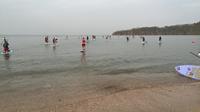Stand Up Paddle Boarding Tour
Panama City, Panama
Trip Type: Stand Up Paddleboarding
Duration: Flexible
SUP (Stand Up Paddleboarding) is experiencing a huge surge in popularity – probably because it’s such a fun way to explore local waters.
Paddle boards look like surfboards, but paddle boarding is very different from surfing. While surfing the primary objective is to catch a wave and ride it to shore, paddle boarding's primary objective is to move from place to place in the water. As a result, paddle boards are generally larger than surfboards so as to be more stable.
More About This Activity All Stand Up Paddleboarding →
SUP (Stand Up Paddleboarding) is experiencing a huge surge in popularity – probably because it’s such a fun way to explore local waters.
Paddle boards look like surfboards, but paddle boarding is very different from surfing. While surfing the primary objective is to catch a wave and ride it to shore, paddle boarding's primary objective is to move from place to place in the water. As a result, paddle boards are generally larger than surfboards so as to be more stable.
The only equipment you need to paddle board is a board and a paddle. Paddle boards are on the expensive side so it is best to rent equipment in the beginning.
The first thing you will want to master is standing up and maintaining your balance on the board. To do this, start in a kneeling position in the center of the board. Then stand up, while staying in the center, keeping your feet wide and your weight equally distributed. Keep your feet flat and try not to grip the board with your toes as this can get uncomfortable. Your toes may even cramp. Like riding a bike, it is easier to maintain your balance on a paddle board when it is moving than when it is stationary.
Once you’re standing, it’s time to practice paddling. If you have previous paddling experience, paddling a paddleboard isn’t much different. Basic strokes include propelling the board through the water and turning. Most people will scrape the side of the paddle board when they first start paddling. To avoid this, use extra wide strokes while you’re learning.
Paddle boards look like surfboards, but paddle boarding is very different from surfing. While surfing the primary objective is to catch a wave and ride it to shore, paddle boarding's primary objective is to move from place to place in the water. As a result, paddle boards are generally larger than surfboards so as to be more stable.
The only equipment you need to paddle board is a board and a paddle. Paddle boards are on the expensive side so it is best to rent equipment in the beginning.
The first thing you will want to master is standing up and maintaining your balance on the board. To do this, start in a kneeling position in the center of the board. Then stand up, while staying in the center, keeping your feet wide and your weight equally distributed. Keep your feet flat and try not to grip the board with your toes as this can get uncomfortable. Your toes may even cramp. Like riding a bike, it is easier to maintain your balance on a paddle board when it is moving than when it is stationary.
Once you’re standing, it’s time to practice paddling. If you have previous paddling experience, paddling a paddleboard isn’t much different. Basic strokes include propelling the board through the water and turning. Most people will scrape the side of the paddle board when they first start paddling. To avoid this, use extra wide strokes while you’re learning.
« Go Back

